Would you like to see a comet or asteroid tonight?
Comets, asteroids and other Near-Earth Objects (NEOs) are a fascinating sight to behold, if you can manage to spot one in the night sky.

Equipment: NikonZ6 Mod camera, Samyang 135mm lens. Comet (stacked): 60 photos (5sec, ISO 640, f2.8 ). Foreground: 5sec , Hdr
Many will remember the appearance of Comet Hale-Bopp in the 1990s, or much more recently, the beautiful sights of Comet NEOWISE and Comet C/2022 E3 ZTF that made headlines around the world and enticed us all to take a look up at the evening sky.
Asteroid Vesta, for example, is one member of the Asteroid Belt that can also be seen, provided you know where and when to look.
But how do you spot comets and asteroids in the night sky? Is there a comet tonight that's visible where you are?
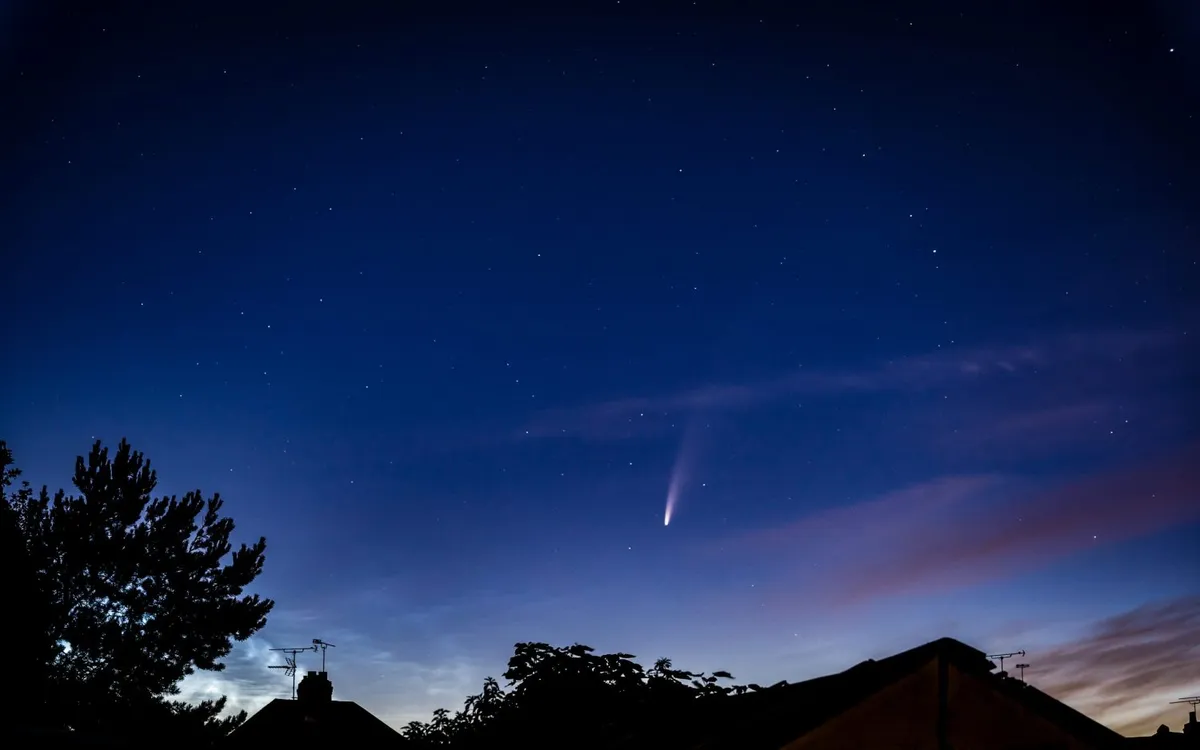
Find out in our guide to which comets and asteroids are visible tonight and over the coming weeks.
For help understanding what our brightness indicators mean, read our guide to stellar magnitude.
If you're a complete beginner, get started with our guide to astronomy for beginners.
April 2025
Asteroid 4 Vesta

Asteroid 4 Vesta reaches opposition on 2 May 2025, when it can be found shining among the stars of northern Libra, close to the constellation’s boundary with Virgo.
At opposition, it’s predicted to reach mag. +5.7, which places it within naked-eye territory from a dark-sky site, although binoculars are a better way to catch it.
On 1 April, mag. +6.6 Vesta sits 3° north of mag. +2.6 Zubeneschamali (Beta (β) Librae), thereafter proceeding to the west-northwest towards the mag. +4.5 star 16 Librae at the start of May.
Its path arcs slightly north as it goes, taking it through a fairly barren part of the spring sky.
Discovered on 29 March 1807, Vesta was the fourth asteroid identified – hence its prefix ‘4’.
It’s the second most massive and second-largest body in the asteroid belt, only surpassed by dwarf planet Ceres, the first asteroid discovered.
1 Ceres was subsequently reclassified as a dwarf planet by the International Astronomical Union (IAU) in 2006, thereafter making Vesta the largest asteroid.
Vesta takes 3.63 years to orbit the Sun and at favourable oppositions can be seen with the naked eye.
Its opposition brightness varies between mag. +5.1 and mag. +8.5. It has been measured as 572.6km x 557.2km x 446.4km, which gives a mean diameter of 525.4km.
March 2025
8 Flora

Minor planet – or asteroid – 8 Flora reaches opposition on 12 March 2025.
It can be found shining at mag. +9.6 within Leo, the Lion, south of Denebola (Beta (β) Leonis), the star that marks the end of the lion’s tail.
Flora begins the month as a mag. +9.8 object in Virgo, 2.3° west-northwest of mag. +4.1 Omicron (ο) Virginis and adjacent to the Virgo–Leo border.
Find out more in our guide to 8 Flora
28 Bellona

Asteroid 28 Bellona is near the Beehive Cluster, M44, in Cancer, the Crab, throughout March
If you can locate it, you should be able to track it as continues towards M44 during March.
Find out more in our guide to 8 Flora and 28 Bellona
February 2025
29 Amphitrite

Minor planet 29 Amphitrite reaches opposition on 12 February, when it can be found very close to the very recognisable Sickle asterism in Leo.
It starts the month 1.5° northwest of mag. +3.5 Eta (η) Leonis, the star immediately north of Regulus (Alpha (α) Leonis).
From here it tracks west and slightly north to end the month 4° south of mag. +4.3 Alterf, Lambda (λ) Leonis.
On 1 February, 29 Amphitrite shines at mag. +9.5, placing it easily within small-scope territory.
Its brightness increases slightly to +9.2 at opposition, then falls back to mag. +9.5 by the end of the month. Its total path length throughout February is just 6.5°.
As ever, the best way to identify a minor planet is to photograph or sketch the area it’s supposed to be in over several nights and compare the results.
If you spot something moving which is in the correct magnitude range, it’s probably your target.
Amphitrite is one of the largest S-type asteroids known, having a mean diameter around 204km. Its solar distance varies from 2.74 AU (410 million km) at aphelion to 2.37 AU (355 million km) at perihelion.
Amphitrite takes 4.09 years to complete each orbit and rotates on its axis once every 5.4 hours.
January 2025

Minor planet 14 Irene reaches opposition on 2 January when it can be found shining against the stars of Gemini at magnitude +9.5.
By the end of the month, it fades slightly to mag. +10.1, making it an ideal target to track down if you have a small or larger telescope.
Irene starts January a little to the east of the mid-point between the two stars that form the ‘body’ of the stick figure of the twin Castor: mag. +4.4 Tau (τ) Geminorum and +3.1 Mebsuta (Epsilon (ε) Geminorum).
Thereafter, it tracks in a linear fashion west-northwest to end the month within the southeast boundary of Auriga. In total, the full track length is a little over 7°, making Irene fairly easy to keep track of once you’ve located it.
As ever with objects of this type, all you’ll see will be a star-like point disguised against the more distant star field background.
In order to identify that you have genuinely observed the body, it’s necessary to record the suspected field over the course of several nights, making note of any objects that appear to move through it.
Irene is a large main-belt asteroid that orbits the Sun at a mean distance of 2.565 AU. Its mean diameter is 152km and it rotates once on its axis in 15 hours.
December 2024
Comet C/2023 A3 Tsuchinshan–ATLAS

Yes, comet C/2023 A3 Tsuchinshan ATLAS is still visible in December 2024, but it's fading fast. Use our chart above to help you find it through a telescope, and read our guide to observing Comet A3 in December.
Asteroid Eunomia

Minor planet 15 Eunomia reaches opposition on 13 December, when it can be found shining at mag. +8.1 among the stars of Auriga.
At this brightness, it’s best viewed using a small or medium telescope.
Find it using our chart above and our guide to Eunomia in December 2024.
November 2024
Comet C/2023 A3 Tsuchinshan–ATLAS

Comet C/2023 A3 is now in a good position for regular observing as it appears to track eastwards above the west-southwest horizon.
It will be visible all month, but the bright Moon interferes from 7–19 November.
During November, C/2023 A3 moves from a location off the eastern shoulder of Ophiuchus, beginning near the V-shaped asterism known as Poniatowski’s Bull and heading towards Aquila the Eagle. It ends the month tucked under the eagle’s western wing.
Asteroid 11 Parthenope

Minor planet 11 Parthenope will reach opposition on 13 November 2024 when it can be found shining at mag. +9.8 on the border between Taurus, Aries and Cetus.
At this brightness, it’ll be most comfortably seen using a small telescope, but binoculars of at least 50mm aperture from a dark-sky site should be able to see it too.
Although opposition delivers us the brightest version of Parthenope, the variation through November isn’t great, the minor planet starting the month at mag. +10.0 and ending it at the same value.
The best way to locate Parthenope is to first locate the pair of stars at the extreme western side of Taurus: Xi (ξ) and Omicron (ο) Tauri.
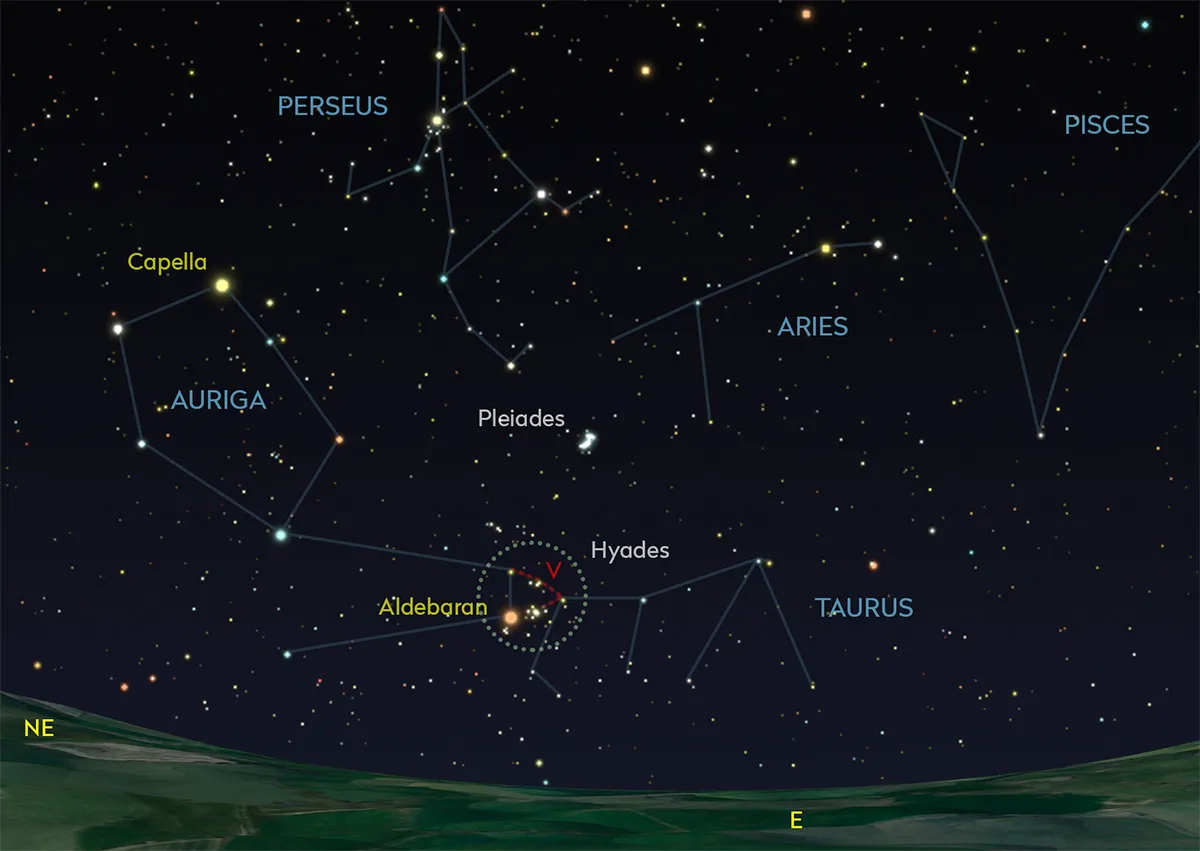
Start from the V-shaped Hyades and follow the direction pointed at by the ‘V’ to reach the variable star Lambda (λ) Tauri.
Return to Aldebaran (Alpha (α) Tauri) and extend a line from it through Lambda for the same distance again to reach Xi and Omicron.
Parthenope will be located approximately 1.3° north of Xi Tauri on the night of 11/12 November.
Throughout the month, the roughly east–west track of Parthenope is less than 7° in length, which makes it a fairly easy target to track.
Parthenope’s orbit takes it out as far as 2.7 AU from the Sun and in as close as 2.2 AU, and takes 3.84 years to complete.
October 2024
Comet C/2023 A3 Tsuchinshan–ATLAS
All eyes are on Comet C/2023 A3 (Tsuchinshan–ATLAS) in October 2024, to see whether the comet lives up to its promise of becoming naked-eye visible.
Clear skies and a flat western horizon will be key to observing Comet A3 from mid-October.

The comet’s closest approach to Earth, at 43.9 million kilometres, occurs on 12 October.
And on 13 October at 20:00 BST (19:00 UT), comet C/2023 A3 will be 4° above the western horizon under deep twilight as seen from the centre of the UK.
The following nights improve, as this distance increases to 6° at the same time on 14 October 9° on 15 October, again at 20:00 BST (19:00 UT).

Keep an eye out for a meeting between comet C/2023 A3 (Tsuchinshan–ATLAS) and globular cluster M5 on 15 October..
This will be quite the photo opportunity, and you can find out more in our guides on how to photograph Comet C/2023 A3 and how to photograph a comet.

C/2023 A3’s altitude improves throughout the rest of October, but its brightness will fall from predicted second magnitude on 11 October to third magnitude on 15 October.
It will drop to sixth magnitude by the end of the month.
Find out more in our guide to observing Comet C/2023 A3 in October, and see if you can spot the comet tonight.
Asteroid 20 Massalia

Minor planet 20 Massalia shines at mag. +9.3 on 1 October, dimming to +10.1 by the end of the month, placing it well within reach of a small telescope.
Finding it will be more of a challenge.
The object is located in Pisces, east of the Circlet asterism. Saturn lies nearby in Aquarius, 14° southwest of the Circlet’s centre, but dim Neptune is the better navigational aid – assuming you can find it, of course!
To locate Neptune and Massalia, you will need to star-hop through some sixth- and seventh-magnitude stars to the east and southeast of the Circlet.
At the start of October, the key star is mag. +5.8 44 Piscium, a double star in Pisces. On the morning of 1 October, Massalia is located just shy of 1.2° north-northwest of 44 Piscium.
Over the course of the month, both Massalia and Neptune perform a westward track that’s parallel with the ecliptic, Massalia’s being 6.3° in length and Neptune’s shorter at 46.3 arcminutes.
At the end of October, Massalia ends half a degree north of the pair HIP 118307 at mag. +6.6 and HIP 14 at mag. +7.3.
Massalia is a large S-type or stony asteroid with a mean diameter of 145km and an orbital period of three years and nine months.
September 2024
Comet C/2023 A3 Tsuchinshan–ATLAS

Comet C/2023 A3 Tsuchinshan–ATLAS is causing a bit of a stir because it has the potential to be visible to the naked eye, from the UK at least, from mid-October when it re-emerges from the Sun’s glare into the evening sky.
As long as nothing catastrophic happens to it, comet C/2023 A3 Tsuchinshan–ATLAS will become a potentially naked-eye object in September 2024.
C/2023 A3’s orbit has it swinging through perihelion on 27 September, between Earth and the Sun, being closest to Earth on 12 October at a distance of 70.6 million kilometres.
At the start of September, the comet is expected to be around seventh magnitude and from the UK will not be visible unless something unusually dramatic happens and it brightens by a large amount unexpectedly.
At this time it’ll be in our daylight sky, 8° south of the Sun.

After mid-September, the comet is in the early morning sky, but very low before sunrise and not visible in a dark sky at all.
Again, something very dramatic would need to happen for it to be visible at this time.
The situation worsens as we go into October, with the comet only 3° from the Sun on 10 October.
However, dire though this sounds, its apparent movement from the Sun is rapid after this and we should get to see it against ever-darkening evening skies from the middle of October onwards.
How bright it gets remains to be seen but, fingers crossed, it should be visible to the naked eye during October.

With a nucleus 20–40km across, C/2023 A3 is interesting because it’s an Oort cloud comet that will reach perihelion on 27 September, when it swings past the Sun at a distance of 58.6 million kilometres.
Perihelion also takes place with the comet moving between us and the Sun, giving rise to some difficult viewing conditions through September and early October.
Minimum distance from Earth is achieved on 12 October, at 70.6 million kilometres.
After solar conjunction on 9 October, when C/2023 A3 will be just 3.5° from the Sun, the comet rapidly moves into the evening sky.
Its peak magnitude could be around +2 to +3 then, but it could also get a post-perihelion boost in brightness from an effect known as forward scattering.
C/2023 A3 seems to be quite a dusty comet, which could give rise to a decent dust tail.
The comet’s inbound orbital period is estimated to be millions of years; how such a frozen body reacts when it gets close to the Sun remains to be seen.
Find out more in our guide to observing Comet C/2023 A3 in October and our beginner's guide to Comet C/2023 A3.
August 2024
Asteroid 16 Psyche

Asteroid 16 Psyche is visible throughout August 2024 and reaches opposition on 6 August 2024.
At this time, it will be visible through a small telescope among the stars of Capricornus, shining at magnitude +9.6.
It will not be visible with the naked eye, but a small telsecope should do it.
Asteroid 16 Psyche begins its August track across the stars from a location 2.4° north of mag. +4.1 Theta (θ) Capricorni.
Find out more in our guide to asteroid 16 Psyche opposition, August 2024.
July 2024

As comet C/2023 A3 Tsuchinshan-ATLAS fades from our skies temporarily (it could to be a showstopper this autumn), turn your attention instead to dwarf planet Pluto, which is also a Kuiper belt object.
Pluto reaches opposition on 23 July 2024 in Capricornus, sitting in 5° northeast of the kite-shaped asterism formed from mag. +4.5 59, +4.8 60, +4.4 62 and +4.7 Omega (ω) Sagittarii.
Find out more in our guide on how to observe Pluto at opposition in July 2024.
June 2024
Comet C/2023 A3 Tsuchinshan–ATLAS

Comet C/2023 A3 Tsuchinshan–ATLAS is the comet on everyone's lips at the moment, as many are hoping it will become a bright object in the sky around September / October 2024.
The comet is already visible in the sky if you know where to look, although it requires at least a small telescope to catch it.
Comet C/2023 A3 is in western Virgo at the start of June, moving out of the Bowl of Virgo asterism into southern Leo.
For help finding it, read our guide on how to locate Comet C/2023 A3 and use the chart above.
Dwarf planet Ceres

Dwarf planet Ceres passes through the Teapot asterism in June and July 2024, ahead of its opposition on 5 July 2024.
This could be a bit of a challenge to spot in the brightening twilight, but read our guide on Ceres and the Teapot for more info on how to locate it.
March 2024
Comet C/2021 S3 PanSTARRS
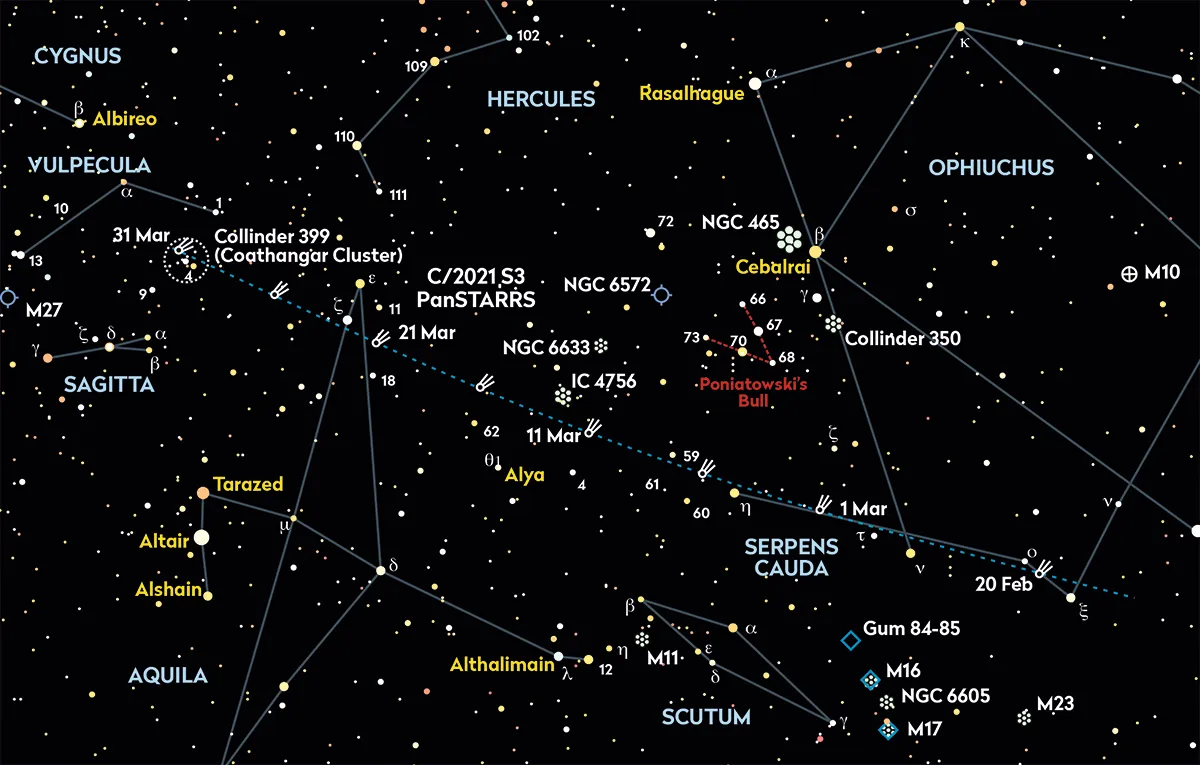
Comet C/2021 S3 PanSTARRS is visible in the morning sky throughout March 2024 and predicted to shine at eighth magnitude, meaning it should be visible through binoculars.
C/2021 S3 PanSTARRS head north-northeast from Serpens Cauda through Aquila, Sagitta and finally into Vulpecula.
Once in Vulpecula, the comet will pass into the deep-sky object known as Collinder 399, Brocchi’s Cluster or the Coathanger Cluster.
Comet 12P/Pons–Brooks
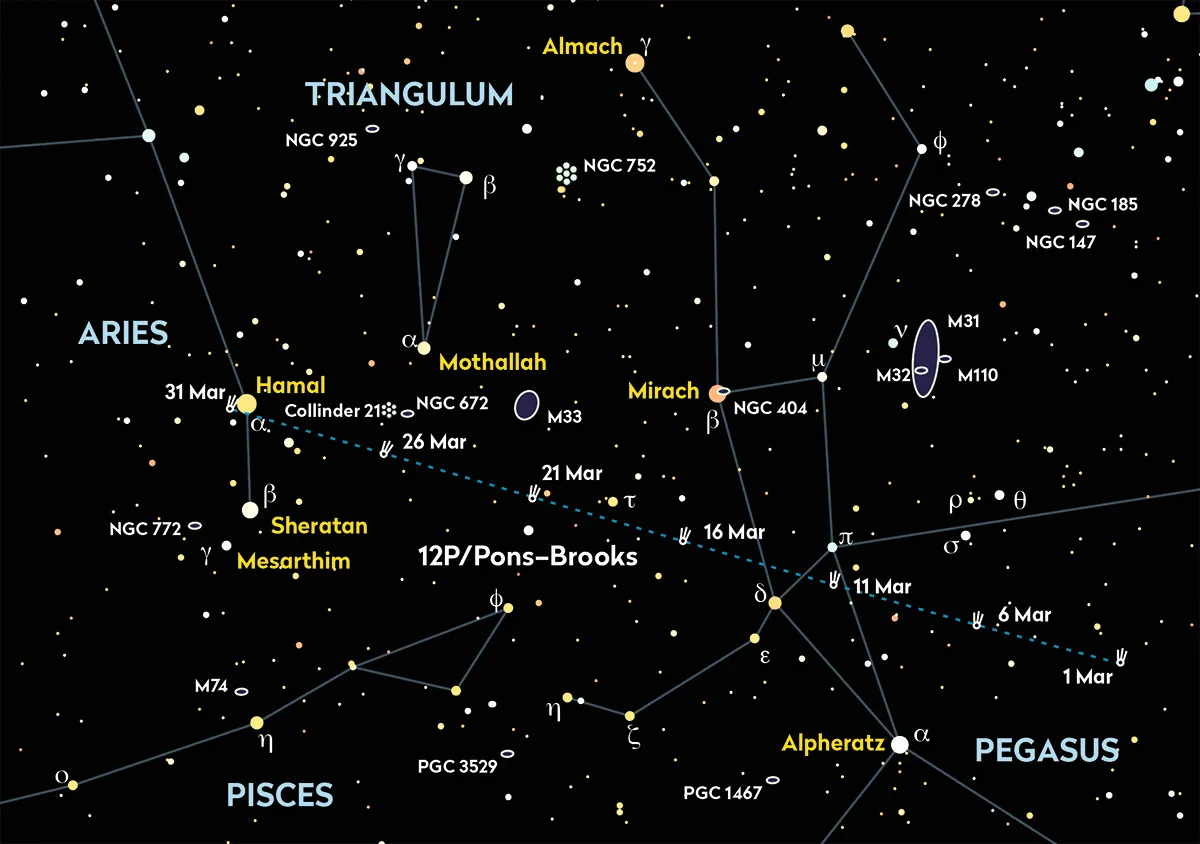
12 P/Pons-Brooks could brighten from mag. 7.1 to 5.2 throughout March, which would take it close to naked-eye territory.
While C/2021 S3 PanSTARRS is best in the early morning sky, 12P is best viewed in the evening sky, which will cause problems given the brightening evenings as we head into April.
Comet 12P/Pons–Brooks begins March north of the Great Square of Pegasus, technically within the constellation Andromeda.
As the sky gets dark from the centre of the UK, it’ll be about 24° above the west-northwestern horizon.
The comet then heads southeast, brightening as it goes.
Asteroid 3 Juno
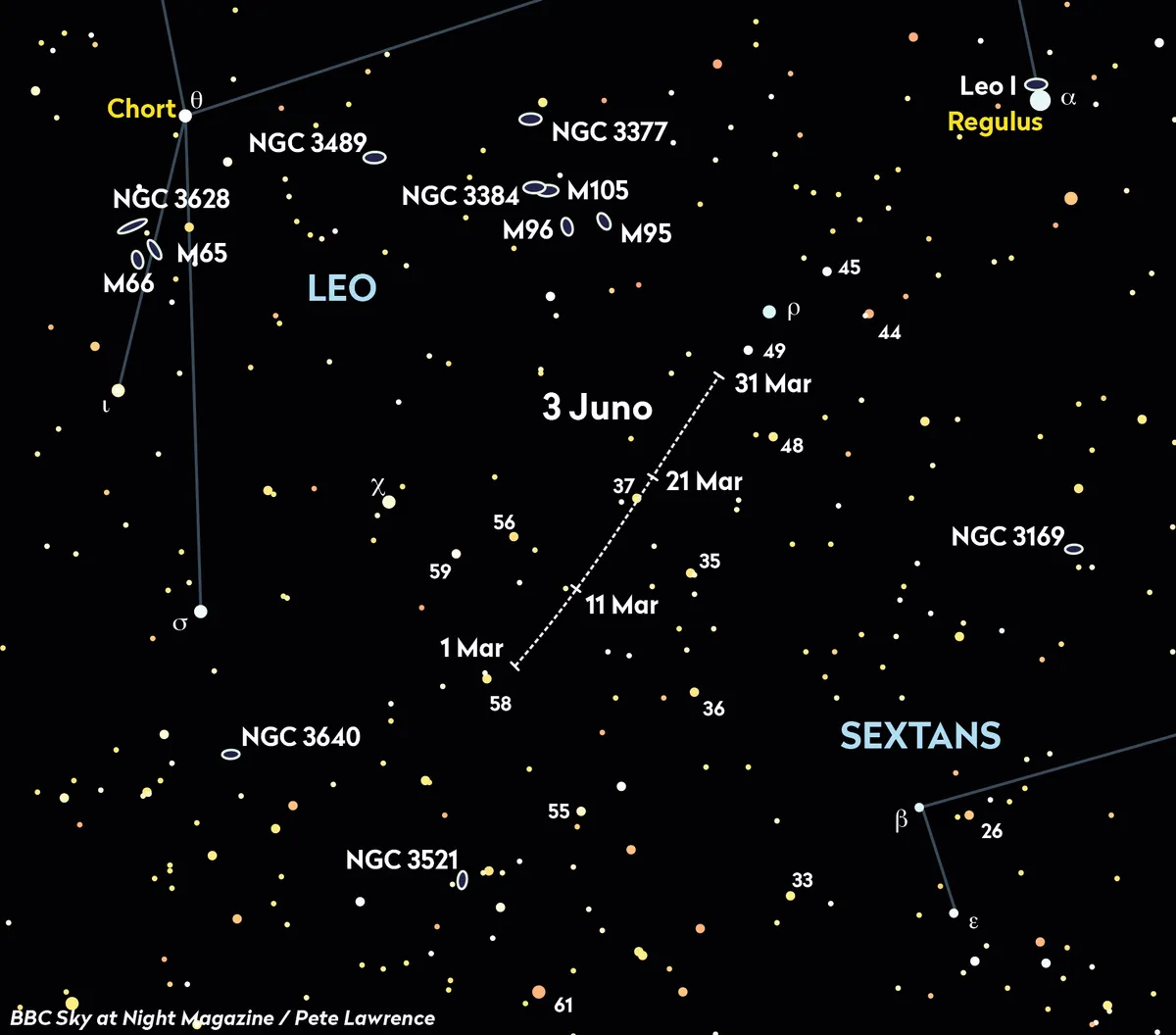
Asteroid 3 Juno reached opposition on 3 March, when it was located in southern Leo near the border with Sextans
It began March close to mag. +4.8 58 Leonis and shining at mag. +8.8 and could be visible through binoculars, but is best through a small telescope
Asteroid 3 Juno is heading northwest throughout March, clipping the border between Leo and Sextans.
February 2024
Comet 62P/Tsuchinshan
Comet 62P/Tsuchinshan, also known as Tsuchinshan 1, will be within the northern part of the Bowl of Virgo during February, situated fairly close to the mag. +4.9 star Rho (ρ) Virginis.
The comet was discovered at the Purple Mountain Observatory in Nanking, China in January 1965, having been identified on a photograph taken on New Year’s Day 1965.
Subsequent observations made via the Mount Palomar Observatory, California in February 1965 allowed an initial orbital period of 7.22 years to be computed, later refined to 6.62 years as more positional data was obtained.
The comet made a close pass of Jupiter in December 1960 which, it was computed, had adjusted the orbital period from 7.15 years to 6.62 years.
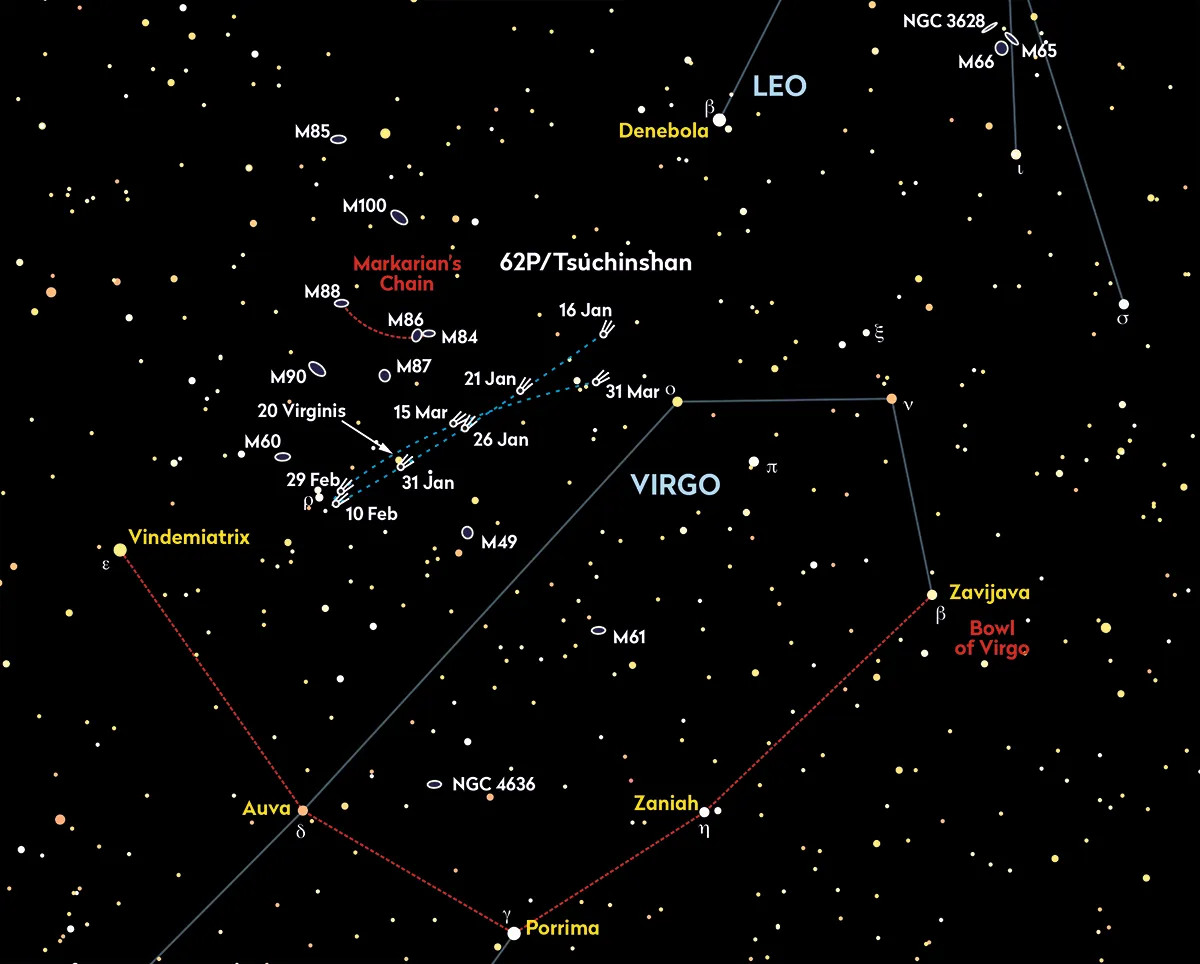
Although typically rather faint, prospects for observing 62P/Tsuchinshan in 2024 are promising.
After last reaching perihelion on Christmas Day 2023, the comet remained around seventh magnitude throughout January.
On 1 February, it is predicted to have an integrated magnitude of +7.8, but is also expected to fade fairly steadily to mag. +9.3 by the end of the month.
The comet’s orbit is inclined to the plane of the Solar System by 10.5°. Perihelion varies over time, but is currently 1.26 AU. Aphelion takes the comet out to a distance of 5.47 AU from the Sun.
The comet’s orbit will have it make a close pass of Mars in 25 years when, on 1 April 2049, it will pass 0.016 AU, which is 2.4 million kilometres, from the Red Planet.
Comet 144P/Kushida
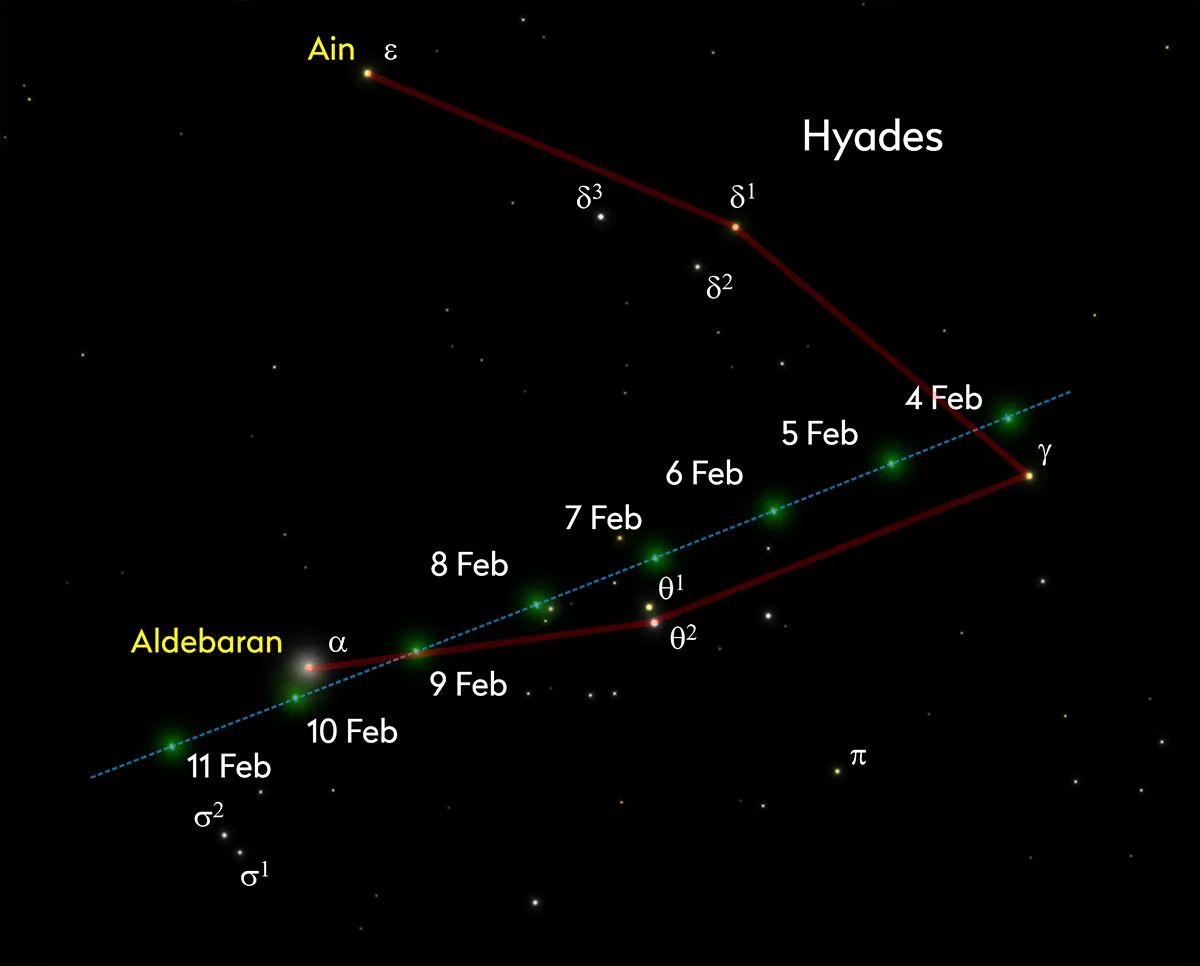
Comet 144P/Kushida is among a collection of comets well placed for Northern Hemisphere viewing in early 2024.
The best time to see 144P/Kushida will be 1–18 and 28 January into early February.
The comet is ninth-magnitude in February, which means it's a good target for a small telescope or larger-format binoculars, and will pass by the Hyades star cluster.
Find out more in our guide to Comet 144P/Kushida
January 2024
Comet 144P/Kushida
Comet 144P/Kushida is well placed for Northern Hemisphere viewing in January 2024.
The best time to catch the comet through binoculars or a telescope will be 1–18 and 28 January into early February
The comet passes from southern Aries at the start January 2024 towards the Hyades in Taurus by the end.
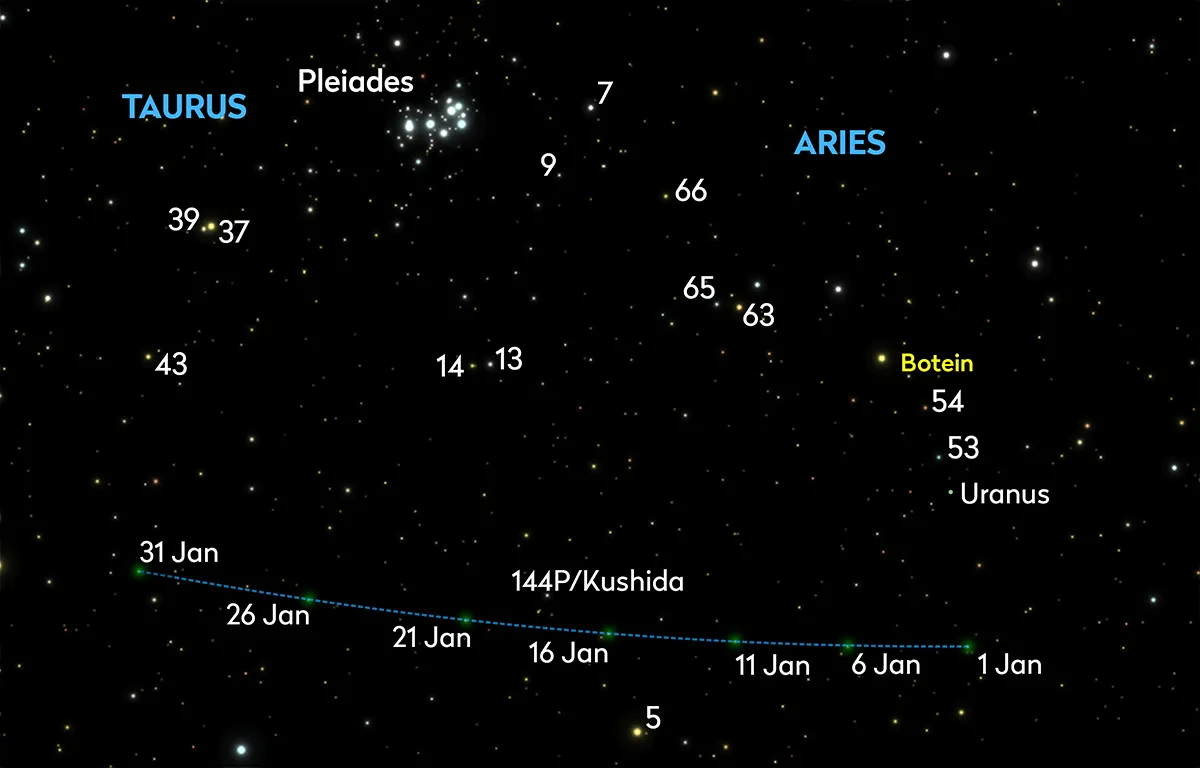
Have you managed to photograph Comet 144P/Kushida? Let us know by emailing contactus@skyatnightmagazine.com.
